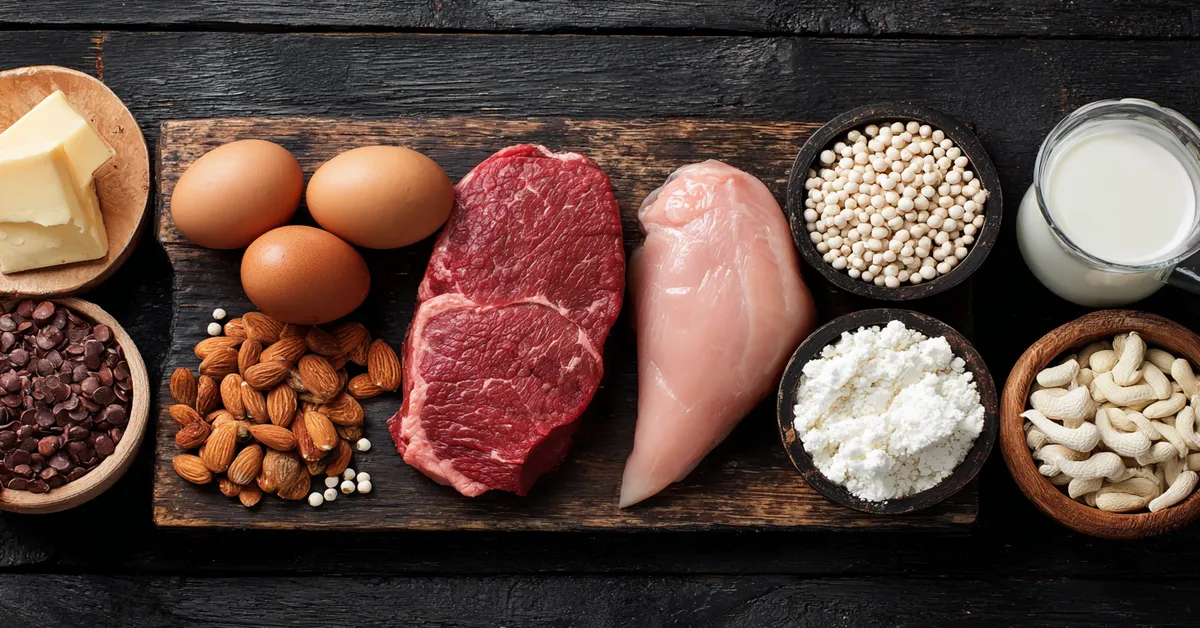The Protein Intake Calculator is your simple way to turn body weight, training style, and goals into a daily protein target you can actually follow. In this fitness guide, you’ll learn how the calculator works, what number to aim for, and how to break that target into meals without overthinking. By the end, you’ll have a science-based plan you can start today.
Table of Contents
ToggleHow the Protein Intake Calculator Works
At its core, the Protein Intake Calculator estimates how many grams of protein you need each day based on:
Body weight (kg or lb)
Goal (fat loss, maintenance, or muscle gain)
Training type (strength, endurance, mixed)
Training frequency (how many hard sessions per week)
From current evidence, useful ranges look like this:
General health: ~0.8–1.0 g/kg per day
Endurance focus: ~1.2–1.6 g/kg
Muscle gain or recomposition: ~1.6–2.2 g/kg
Energy deficit (cutting): ~1.8–2.4 g/kg to help retain lean mass
The Protein Intake Calculator maps you to one of these ranges, then refines the number using your training load and body fat level (leaner athletes usually need less per kg than those with higher body fat when cutting).
How to Use the Protein Intake Calculator (Step-by-Step)
Enter weight. If you know your body fat, use the lean-body-mass option for a tighter estimate.
Pick a goal. Cutting, maintaining, or gaining.
Select training type and frequency. More lifting or more miles will shift the target.
Get your daily grams. The Protein Intake Calculator returns a range and a best-fit recommendation.
Split across meals. Aim for 0.30–0.40 g/kg per meal, spread over 3–5 meals. That distribution supports muscle protein synthesis throughout the day.
Example: 75-kg lifter on a lean bulk → ~1.8 g/kg = 135 g/day. Split into four meals: ~34 g each.
To keep things consistent, pair your protein plan with your energy target. Calculate daily calories with our TDEE Calculator and set a small surplus for massing or a sustainable deficit for cutting. For context on body size, check your BMI and Body-Fat & BMR.
Protein Intake Calculator for Fat Loss
When calories drop, protein does a lot of heavy lifting: it preserves lean mass, supports satiety, and keeps your training quality up. The Protein Intake Calculator will nudge you toward the high end of the range—typically 1.8–2.4 g/kg—especially if you’re training 3–5 days per week. Combine that with fiber-rich carbs and moderate fats for meals that keep you full.
Helpful tools while cutting:
Calorie & Nutrition Calculator for meal planning
Fat Intake Calculator to balance macros
VO₂ Max Calculator to track cardio fitness
Protein Intake Calculator for Muscle Gain
For hypertrophy, the sweet spot is generally 1.6–2.2 g/kg with hard, progressive training. The Protein Intake Calculator will land you near the center of that band and show a per-meal target. Don’t chase extreme numbers—more isn’t always more. Prioritize quality training, sufficient calories, and regular protein hits across the day.
Pair with:
TDEE Calculator to set a small surplus
Calorie & Nutrition Calculator to plan meals you’ll stick to
What to Eat to Hit the Number
Lean meats & fish: chicken breast, turkey, lean beef, tuna, salmon
Dairy & eggs: Greek yogurt, cottage cheese, eggs
Plant proteins: tofu, tempeh, seitan, lentils, beans, edamame
Supplements: whey or plant blends can help close gaps
Aim to include 25–40 g protein per meal, adjusted to body size. The Protein Intake Calculator will suggest a meal split to make this effortless.
Common Mistakes the Calculator Helps You Avoid
Undereating on training days. Your best lifts need fuel and protein; keep the target steady.
One giant protein meal. Muscle protein synthesis benefits from even distribution.
Ignoring total calories. Protein targets work best inside the right energy intake—set that first.
Guessing portions. Use a digital scale for a week to calibrate your eye, then relax.
Quick FAQ
Is higher always better?
No. The Protein Intake Calculator chooses a ceiling that’s helpful, not excessive. Most lifters thrive at 1.6–2.2 g/kg.
Do I need protein shakes?
Not required. Food first; shakes are convenient, especially post-workout or when traveling.
Can I do this while vegetarian or vegan?
Yes. Mix sources to cover amino acid profiles—soy, legumes, grains, nuts, and seeds. The calculator’s daily number stays the same.
How does this fit with overall health?
Protein supports recovery and healthy aging. Keep an eye on fiber, fruits, vegetables, and hydration. For a broader check, try our Calorie Deficit Calculator and Health & Fitness Calculators hub.

Trusted Resources to Learn More
International Society of Sports Nutrition—Position stand on protein and exercise (evidence overview).
U.S. National Institutes of Health—Protein basics and daily intakes for the public.
